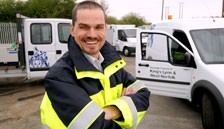Introducing green policies could be an “easy win” for fleet managers, according to Nathan Johnson, public open space manager at King’s Lynn and West Norfolk Borough Council.
“In this financial climate everyone is looking to make savings and introducing environmental policies could be an easy win,” Johnson says.
“It’s about managing your fleet in a professional way and getting value for money out of your vehicles.”
Johnson is responsible for the council’s 42 light commercial vehicles and has decided that the best way to get value for money out of them is by fitting telematics.
This is predicted to save about 10% on fuel, as well as reducing carbon emissions.
The council began trialling telematics in 2007 and is now rolling out an instalment programme to the rest of the fleet.
Already, 32 vehicles have been fitted with the web-based Trakm8 system and Johnson plans to complete the programme by the end of the financial year next March.
Less engine idling
Telematics has provided Johnson with useful management information such as vehicle location, mileage, speed and stop/start patterns.
In particular, the system has allowed him to identify drivers that were leaving the engine running in their van while they went off to perform duties, such as emptying litter bins.
“We discovered one vehicle was idling for three hours a day,” he says.
“That used about three gallons of fuel. We informed the driver and showed him the cost, which was roughly £12 to £13. We’ve seen idling drop significantly.”
And of course, this has also meant a drop in CO2 emissions.
Telematics has allowed drivers to cut back on unnecessary journeys too.
“If we receive a phone call telling us a bin isn’t empty we can look at the map online, see which vehicle is nearest to it and phone the driver,” says Johnson.
“Before we had telematics that job would have gone in a tray in the office and wouldn’t have been dealt with until the driver returned.
"Having telematics means drivers no longer need to keep making journeys back to our department to pick up work.”
Johnson can also identify if any vehicles are located ‘out of bounds’, as some vehicles are supposed to cover certain areas.
Employee safety
There have been health and safety benefits too.
“We’re the sixth largest rural authority in the country – we cover 550 square miles – and we’ve got a number of lone workers,” Johnson explains.
“Telematics allows us to see where those lone workers are.”
The other benefit from a health and safety point of view is knowing when drivers are speeding. Johnson says that he, or the relevant line manager, will receive an email alert informing them if a driver has been speeding.
Johnson believes that all of these benefits outweigh the cost of the system (each unit costs £170 and monitoring is 46p per vehicle per day).
To keep costs to a minimum Trakm8 has now trained council staff to install the units.
Convincing drivers
But if another fleet manager wanted to install telematics, how would they persuade drivers it was a good thing?
“Our drivers were concerned at first. But we reassured them it wasn’t being used for surveillance,” says Johnson.
“Each time we fit the system to a new vehicle we bring the driver in and show them what the system is capable of and what information and data we are getting from it.
“The drivers are quite relaxed about it now and the fin-ance director and personnel managers have fully embraced it.”
But Johnson suggests telematics may not suit all fleets: “It’s best suited to fleets that need to react to jobs quickly, like us.”
Other ways to go green
Telematics has been the council’s main carbon-cutting measure but Johnson says investing in fleet software last year has also helped him to monitor and manage fuel.
Speed limiters (set at 56mph) are on the agenda too – Johnson plans to make them standard on all replacement vehicles.
“We’re fitting them so we can ensure that our drivers are not tempted to speed, particularly due to the rural nature of the borough.”
There’s been no adverse reaction from drivers, according to Johnson, as a number of staff briefings have been held.
He has been considering electric and hybrid vehicles for the fleet as well.
“We had four electric vehicles on trial. Unfortunately they weren’t fit for purpose – the battery life wasn’t sufficient to carry out the ground maintenance duties – but we are considering trialling others. We’re also looking into hybrid vehicles.”
Driver training is being set up with the intention of promoting greener and safe driving techniques.
Drivers will be encouraged to take pledges against actions such as excessive idling, harsh acceleration and harsh braking.














Login to comment
Comments
No comments have been made yet.